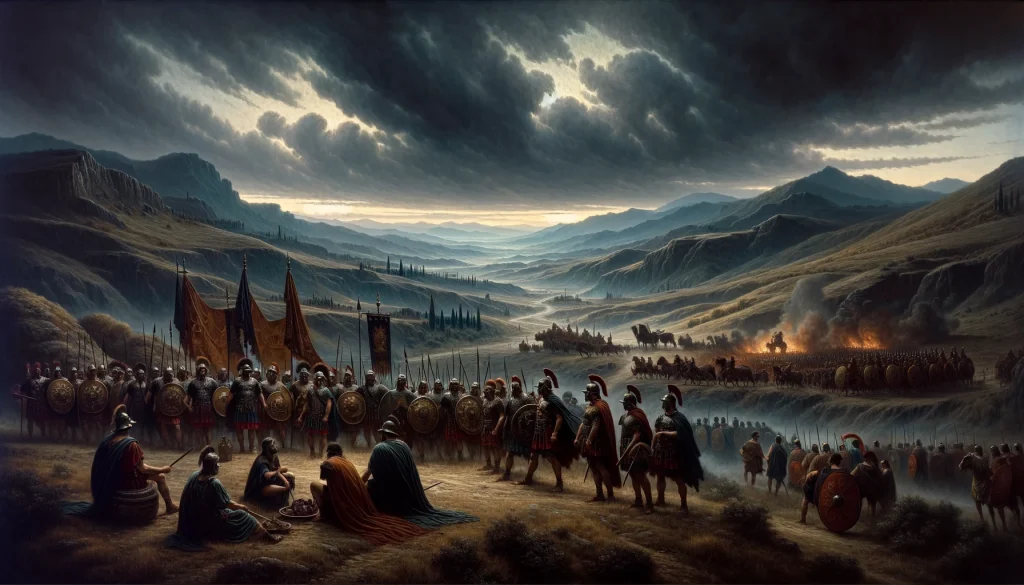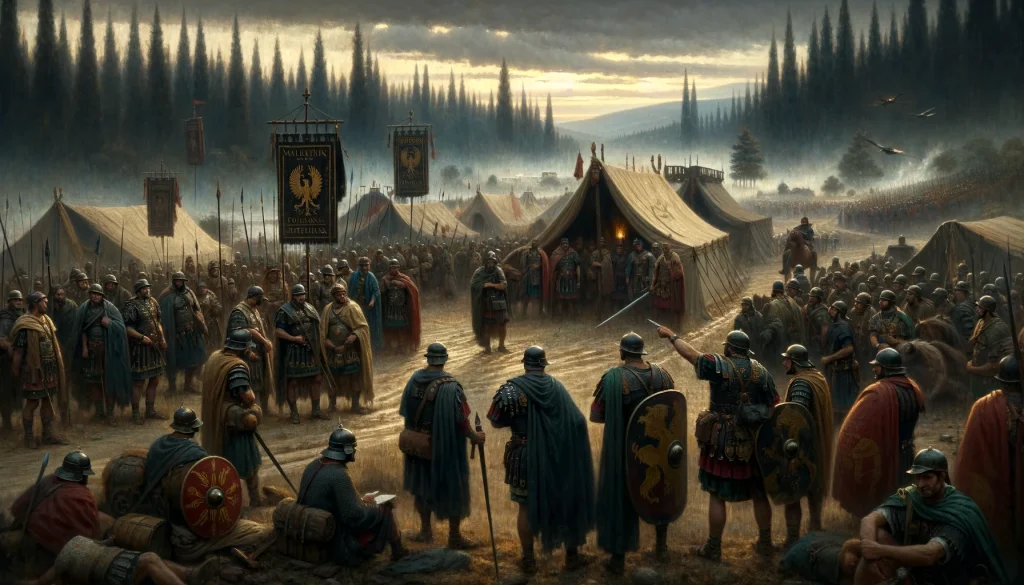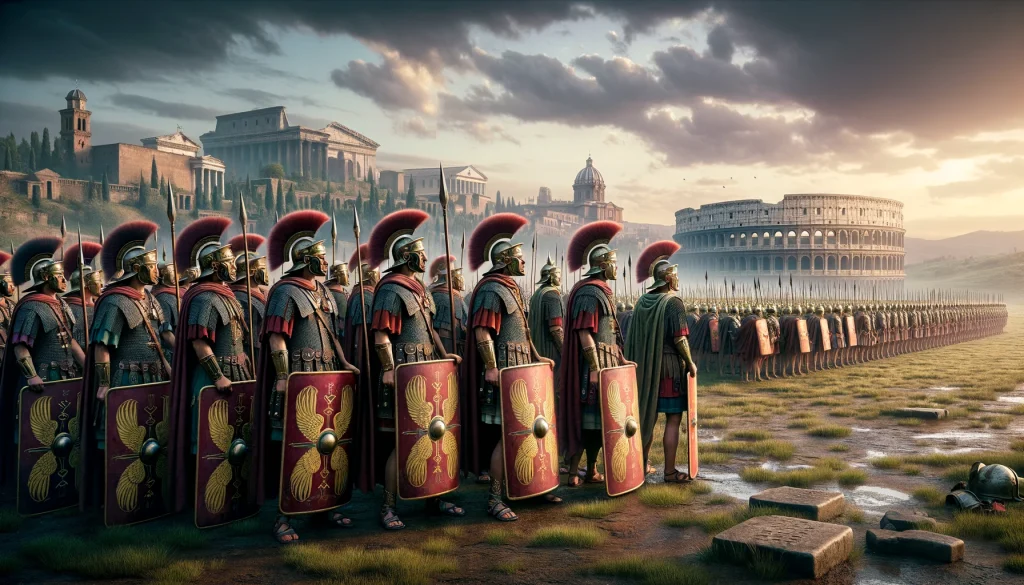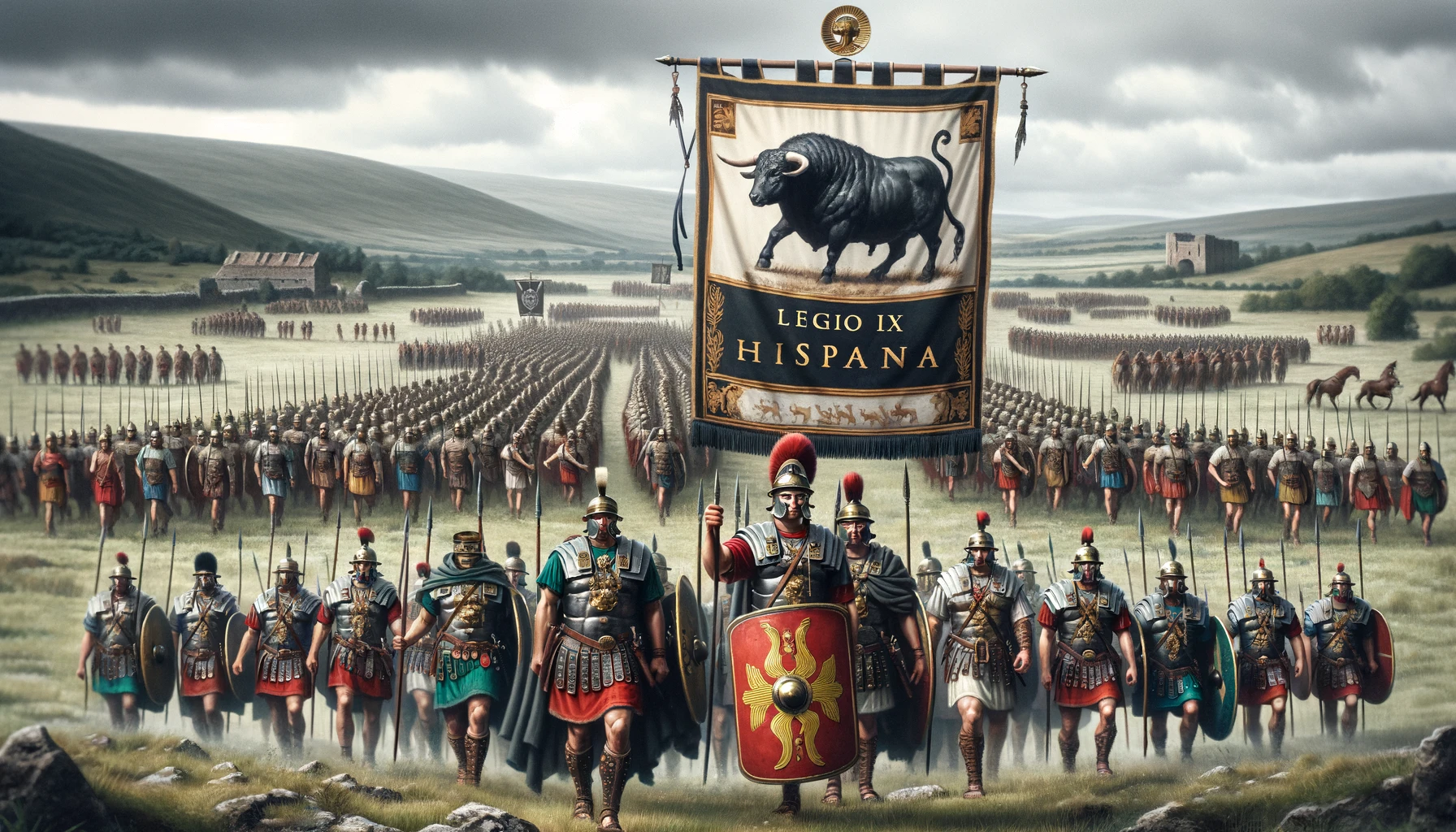Legio IX Hispana, a notable Roman legion, participated in campaigns with Julius Caesar in Gaul and against Pompey during the Civil Wars. Subsequently, it joined forces with Augustus in the Cantabrian Wars. This legion was also part of the four that Emperor Claudius brought along for the 43 CE conquest of Britain. Despite facing mutiny and near destruction on two occasions, it managed to regain its strength. The legion endured significant losses in Boudicca’s uprising but later made a comeback, supporting Agricola in his campaigns against the Caledonians. Its existence is last recorded around 120 CE, after which it vanished from historical records.
Early History of Legio IX Hispana

Legio IX in the Gallic War
The Ninth Legion, established in 57 BC, played a notable role in the Gallic War, as documented by Gaius Julius Caesar. During the Battle of the Sabis River (Selle), it joined forces with the Tenth Legion on the left flank to confront the Atrebates.
The soldiers of the ninth and tenth legions, as they had been stationed on the left part of the army, casting their weapons, speedily drove the Atrebates… [and]… slew with their swords a great part of them
The Gallic Wars: Julius Caesar
Meanwhile, the Eighth Legion and others faced different opponents, with the Thirteenth and Fourteenth Legions providing rear guard support. Initially, Roman forces achieved success, notably the Eighth Legion driving back the Atrebates. However, the Belgae soon breached the Roman camp, encircling the right flank. Many auxiliary forces retreated, and allied Treveri abandoned the battle, returning home without engaging. The situation was salvaged by the prompt intervention of the rear-guard and the strategic manoeuvring of the left wing, securing victory for Caesar.
By 51 BC, the legion remerged in historical records, this time in response to a revolt led by Correus, involving the Bellovacians, Ambians, Aulerci, Caletes, Veliocassians, and Atrebates. To counter this, Caesar established a fortified camp within view of the enemy and summoned reinforcements from the Remer, Lingones, and three additional legions. This strategic positioning and reinforcement led to a pivotal battle that quelled the uprising.
Legio IX in the Civil War

The legion was engaged in the civil war against Gnaeus Pompeius Magnus, initially positioned in Spain. During the summer of 49 BC, it, along with Legio VI Ferrata and Legio XIIII Gemina, overcame Pompey’s supporters near Ilerda (Lleida). Subsequently, the legion was transferred to Greece, where it participated in the Battle of Dyrrhachium in 48 BC, incurring significant casualties. In the same year, at the Battle of Pharsalus, it joined forces with the equally depleted Legio VIII, under the collective command of Marcus Antonius.
We hear from the historian Appian that the Legio IX were threatened with decimation after they mutinied at Placentia. Caesar travelled from Massilia to Placentia to personally address the troops.
You know what kind of speed I use in everything I undertake. This war is not prolonged by us, but by the enemy, who keep retiring from us. You reaped great advantages from my command in Gaul, and you took an oath to me for the whole of this war and not for a part only; and now you abandon us in the midst of our labours, you revolt against your officers, you propose to give orders to those from whom you are bound to receive orders. Being myself the witness of my liberality to you heretofore I shall now execute the law of our country by decimating the ninth legion, where this mutiny began.
The Histories of Appian, The Civil Wars, Book II
Following this, there were plans for the legionnaires to retire in Italy, yet it is confirmed that they engaged one final time in 46 BC during Caesar’s African campaign at the Battle of Thapsus. After disbandment, many veterans settled in Picenum and Histria. In 43 BC, Publius Ventidius Bassus reenlisted the veterans, although the legion was shortly thereafter disbanded again.
Caesar’s IX was reformed by Ventidius Bassus c.44 BC, but were soon disbanded once more.
Octavian’s Legio IX

Around 43 BC, Octavian, who would later become Augustus, re-established the legion. It is possible that as early as the autumn of 42 BC, the legion, operating as Legio VIII triumphalis, participated victoriously in the Battle of Philippi against Caesar’s murderers, earning the epithet Macedonica. Another perspective suggests it was formed around 41 BC to address Sextus Pompey’s seizure of Sicily. Subsequently, the legion was deployed to the Balkan Peninsula, where it acquired its new designation, Legio VIII Macedonica. During the conflict with Marcus Antonius, the legion notably engaged in the crucial Battle of Actium in 31 BC.
In 25 BC, Legio VIII Macedonica embarked on an eight-year campaign against the rebellious Iberians in the province of Hispania Tarraconensis. The legion’s exceptional performance in these campaigns against the Cantabrians, known as the Cantabrian Wars, earned it distinction, and it left Spain with the title Legio VIII Hispaniensis. By 19 BC, the legion had been redeployed to Illyricum, likely stationed in the strategically significant city of Aquileia, where it is referenced in an inscription as Legio VIIII Hispana. From 11 BC, as part of the reorganization of the Exercitus Illyricus (Illyrian Army), the legions were moved further inland. During the division of the province in AD 8 amidst the Pannonian Revolt, the legion was relocated to Illyricum Inferius, later known as Pannonia, with its winter camp established in Siscia (Sisak) until the year 43.
Following Augustus’ death, AD 14 witnessed unrest at the Pannonian legions’ common summer camp (involving Legio VIIII Hispana, Legio XV Apollinaris, and Legio VIII Augusta). However, Drusus the Younger swiftly and efficiently quelled the disturbance, leading to the legions returning to their respective winter camps.
In AD 17, a conflict erupted in the Roman province of Africa against insurgent Numidian and Mauritanian tribes under Tacfarinas. By AD 20, Legio VIII Hispana, under the command of legate Publius Cornelius Lentulus Scipio, was dispatched to Africa to support Legio III Augusta. The rebellion was eventually quelled in AD 24 by Proconsul Quintus Iunius Blaesus, after which VIII Hispana returned to Pannonia, presumably to its former camp in Siscia.
Soon after the move to Germany, Legio IX acquired its permanent title Hispaniensis, meaning ‘stationed in Spain’. Later the form Hispana (‘Spanish’) was preferred. The title was in use by the middle of Augustus’ reign (attested by ILS2321). Another of the legion’s titles, Macedonica, was awarded after service in the Balkans sometime during the early Julio-Claudian era. (Vide Legio II Augusta)
Legio IX Hispana’s Service in Britain
The Ninth Legion saw active service during the Claudian Invasion of Britain under Aulus Plautius in AD43 and was thereafter divided between Vexillation Fortresses at Longthorpe near Peterborough in Cambridgeshire and at Newton-on-Trent in Lincolnshire before their legionary fortress was built c. AD65 at Lincoln (Colonia Lindum).
During the early stages of the Boudiccan Revolt of AD60/61 the legionary legate Quintus Petillius Cerialis, tried to use IX Hispana to prevent the sack of London (Londinium), however, the legion was badly mauled and was forced to retire to its campaign fortress at Longthorpe Roman Vexillation Fort. The Ninth later had its complement made good with a contingent of two thousand men taken from the legions stationed on the Rhine (Tacitus, Annals, XIV:38).
The Legion moved from its fortress at Lincoln (Colonia Lindum) Roman Settlement to a campaign fortress at Malton (Derventio) in North Yorkshire in AD71, and were replaced at Lincoln (Colonia Lindum) by Legio II Adiutrix. The proconsular governor Q. Petillius Cerialis then took personal command of his old legion, and together with Legio XX Valeria Victrix commanded by the legate Agricola , moved against the forces of Venutius of the Brigantes . Legio IX Hispana comprised the main force and moved along the vale of York, while XX Valeria moved up the western side of the Pennines in a pincer movement, crushing the forces of Venutius in a pitched battle at Stanwick.
Evidence for Legio IX Hispana in Lincoln (Colonia Lindum)
RIB 256 - Funerary inscription for Lucius Sempronius Flavinus
Lucius Sempronius Flavinus, soldier of the Ninth Legion, in the century of Babudius Severus of seven years’ service, aged 30, a Spaniard, of the Galerian voting-tribe, from Clunia.
VINI MILTS LEG VIIII
𐆛 BABVDI SEVERI
AER VII ANOR XXX
ISPANI GALERIA
CLVNIA
Clunia, Hispania Tarraconensis.For aerorum on a Spanish tombstone see CIL ii 5265 L. Aelius L. f. Gal. Celer Clun.; for Colchester see RIB 201.
RIB 257 - Funerary inscription for Gaius Valerius
Gaius Valerius, son of Gaius, of the Maecian voting-tribe, soldier of the Ninth Legion, standard-bearer of the century of Hospes, aged 35, of 14 years’ service, left instructions in his will for this to be set up. Here he lies.
MAEC MIL LEG
IX SIGN C HOSPITIS
ANN XXXV STIP XIIII
T P I
H [...]
No commentary.
RIB 255 - Funerary inscription for Gaius Saufeius
To Gaius Saufeius, son of Gaius, of the Fabian voting-tribe, from Heraclea, soldier of the Ninth Legion, aged 40, of 22 years’ service he lies here.
G F FAB HER
MILITI LEGIO
VIIII
ANNOR XXXX
STIP XXII
H S E
2. Heraclea, in Macedonia.
RIB 249 - Funerary inscription for Marcus Aurelius [...]us
Marcus Aurelius […]us, freedman of Marcus Aurelius [Max]sumus, of […]cinum, aged 35 (or 45 or 85), […]si(us) […]lenius, veteran from the Fourteenth Legion [Gemina], his heir, set this up in accordance with his will.
[6]VS M AVRE
[...]SVMI LIB
[4]CINO
[...]XXXV
[6]SI
[...]LENIVS VE
[...] EX LEG XIIII
[...] H E TEST P
4. …]cino For this place-name Ticinum (Italy, reg. xi) is too short; Barcino (Hisp. Tarrac.) should be Barcinone (in abl.), or be abbreviated to Barcin. or Barc. R.P.W.
RIB 260 - Fragmentary funerary inscription
[..]rcu[…]s, son of Marcus, of the Camilian voting-tribe, from Pisaurum, soldier of the Ninth Legion, ..
[...]S M [...]
CAMILIA PISA
VRO MIL
LEG V[... ...]
No commentary.
Evidence for Legio IX Hispana in York
RIB 659 - Altar dedicated to Silvanus
To the holy god Silvanus, Lucius Celerinius Vitalis, cornicularius of the Ninth Legion Hispana, with this offering gladly, willingly, and deservedly fulfilled his vow. Let the gift, this very gift, form part: I must beware of touching.
SILVA[... ]
L CELERIN[...]VS
VITALIS CORNI
LEG VIIII HIS
V S L L M
ET DONVM HOC DONVM
ADPERTINIAT CAVTVM ATTIGGAM
This inscription must antedate the arrival of the Sixth Legion at York about a.d. 120. Addenda from RIB+add. (1995): cornicularius: see the Glossary.
RIB 665 - Building inscription of Trajan
The Emperor Caesar Nerva Trajan Augustus, son of the deified Nerva, Conqueror of Germany, Conqueror of Dacia, pontifex maximus, in his twelfth year of tribunician power, six times acclaimed imperator, five times consul, father of his country, built this gate by the agency of the Ninth Legion Hispana.
[... ]ERVAE FIL NE[...]
[... ]ANVS AVG GER[ ... ...]NTIFEX MAXIMV[ ... ...]TESTATIS XII IMP V[ ...]
[...] PER LEG VIIII HI[...]
No commentary. Addenda from RIB+add. (1995): Trib. pot. XII: 10 Dec. 107-9 Dec. 108. Birley, Review, 228, draws attention to the beautiful reconstruction drawing in RCHM Eburacum [Pl. 41] where in 5, imp v[i] should have been drawn. This would move p(ater) p(atriae) to 6, which J. C. Mann has noted (to R.S.O.T.) may have been centred to balance (1) imp caesar, without the conjectured but redundant portam and fecit.
RIB 673 - Funerary inscription for Lucius Duccius Rufinus
Lucius Duccius Rufinus, son of Lucius, of the Voltinian voting-tribe, from Vienne, standard-bearer of the Ninth Legion, aged 28, lies buried here.
L VOLT RVFI
NVS VIEN
SIGNIF LEG VIIII
AN XXIIX
H S E
No commentary.
RIB 680 - Funerary inscription for Gaius
To Gaius …, son of Gaius, of the Claudian voting-tribe, from Novaria, … of the Ninth Legion Hispana, his heirs and freedmen set this up to their own well-deserving patron.
[... ]OVARIA
[... ]X HISP HERE
[...] PATRONO
[... ...]ENTI FECERVNT
Novaria (now Novara) lies west of Milan, and belonged to Claudia tribus. As the Sixth Legion replaced the Ninth Hispana at York about a.d. 120, the person here commemorated must have died by that time, or, if in retirement, within a few years of that date.
Uncertain History After Britain
The presence of Legio IX Hispana is attested at Nijmegen though not dated. It is possible that they were stationed here for a few years after leaving Britain c. AD120 before being posted to the East.
An alternative suggestion is that the Ninth Legion were set to work with the other three British legions on Hadrian’s Wall for a time after AD122, but the section they were allocated was the turf wall to the west, and thus left behind no inscribed masonry attesting their presence.
Another suggestion, also tentative, is that the Ninth Legion acted with great cowardice during an attack from the tribes of the Caledonian Lowlands c. AD125, and that the soldiers so disgraced themselves that the legion was disbanded and the mention of its name – and therefore the recording of its fate – was forbidden.
Then again, Legio IX Hispana was perhaps annihilated in Judaea under Hadrian, AD132 to 135, or later under Marcus Aurelius, in Armenia, AD161. No longer thought to have been destroyed in Britain, but to have been transferred, first to Germany, and then to the East. (see Dio lxxxi.2 on a disaster AD161).
It has also been suggested that Legio IX Hispana may have been lost in Cappadocian campaigns of AD161 or on the Danube during the AD162 revolt of the Chatti.
The Fate of Legio IX Hispana
Roman historians were extremely reticent in recording the fate of legions which had been disgraced, and the recording of their fate may have been constitutionally banned. Similarly, those legions which were annihilated in battle were not generally made known for reasons of continuing public morale and perhaps, to ensure political stability.
An inscription found in Rome (I.L.S. 2288) and dated to the reign of Marcus Aurelius ( AD161- AD180) lists twenty eight legions in west-east order, with IX Hispana and XXII Deiotariana missing, the latter legion had been part of the Garrison of Egypt since c.25bce, and were possibly destroyed or disbanded under Hadrian in Judaea c. AD132-135.
The tombstone of Titus Flavius Virilis, found at Lambaesis in North Africa, adds further to the mystery. He apparently held the centurionate in six legions, his last post being Hastatus Posterior Legio IX, he died in service whilst training recruits aged about 65. Since his last posting was with the Ninth Legion and he died in service, this must surely mean that at least part of the legion was stationed for some time in Africa.
Vexillations from Legio IX Hispana
The campaigns of emperor Domitian in AD83 against the Chatti in the Taunus region of the Middle Rhine called for vexillations from all four British legions (i.e. Legio II Augusta, Legio II Adiutrix, Legio XX Valeria Victrix and, of course, the Ninth). The senior tribune of Legio IX Hispana was decorated during this campaign (I.L.S., 1025).
It is possible that a vexillation of the Ninth were sent to the lower Rhine during the second Dacian War c. AD86 when Legio II Adiutrix was removed from Britain and Legio VI Victrix, then based at Vetera on the Rhine was reduced in strength and a vexillation of this legion moved to the east.
Following the removal of Legio X Gemina from Noviomagus (Nijmegen, Netherlands) in Batavia in AD104, a considerable amount of reconstruction was undertaken at the Nijmegen fortress by a vexillatio Britannica, it is possible that a detachment of the Ninth Spanish Legion were responsible for this work.
The last known testament of the Ninth Legion’s activities in Britain are legionary stamps associated with the rebuilding in stone of the legionary fortress at York (Eburacum) Roman Settlement in AD108. The Ninth Legion disappeared from York c. AD120, and were replaced by Legio VI Victrix, brought from Germany by Aulus Platorius Nepos c. AD122, and stationed in the newly-rebuilt fortress.
